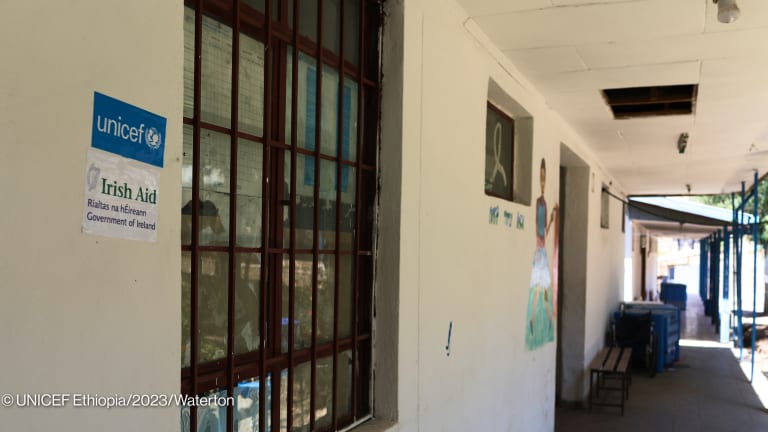How does the United Nations fund development?
The United Nations’ income grew from $58.8 billion in 2017 to $65.9 billion in 2021. We looked into the data to see where the money came from and where it was spent.
Ahead of the high-level general debate of the 78th session of the United Nations General Assembly, Devex took a deep dive into the U.N. system’s complex financial structure to understand how it generates its income, which among its agencies receive the largest share, and where it spends its money. Established in 1945, the U.N. has remained one of the most vital institutions in the global development sector, delivering projects in a range of areas, including climate change, education, health, and social infrastructures. It is composed of specialized agencies, programs, and funds, each with its own mandate. In this piece, we looked into the U.N.’s financial data between 2017 and 2021, as published by the U.N. System Chief Executives Board for Coordination, or CEB. Although the high-level data for 2022 and 2023 is available from other sources, a breakdown of income and expenses is only available up to 2021. Finally, we converted all figures from the CEB data to 2021 U.S. dollar constant prices — allowing us to see trends and make conclusions with respect to fluctuations in inflation rates. How does the UN generate its income? The U.N.’s income primarily comes from the contributions of its 193 member states. These are classified into two main categories — assessed contributions, which accounts for around 20% to 26% of the total income, and voluntary contributions, which makes up for around 65% to 71%. Less than 10% of all income is earned income, which falls outside these categories. Assessed contributions are mandatory payments from member states. These contributions are divided further into two streams: regular budget and peacekeeping operations budgets, known as PKOs. Each of the members’ contributions to the regular budget is determined through a complex formula that takes into account their capacity to pay — including their national wealth, debt level, and per capita income. The percentage of required contribution ranges from 0.001% to a maximum ceiling of 22% of the U.N.’s total regular budget. The low rate ensures that even the lowest-income countries could make contributions. Currently, only the United States has reached the maximum point. PKOs are also funded based on the countries’ capacity to pay. The five Security Council members — the United States, United Kingdom, France, Russia, and China — account for the biggest share of the budget, as they cover the discounts given to low-income countries. There are nine active peacekeeping operations as of June 2023, with an approved budget of $6.1 billion to cover the needs until June 2024. According to the data from CEB, despite the increase in the number of agencies reporting their income, the total earning from assessed contributions saw a steady decrease within the five-year period — from $15.4 billion in 2017 to $13.6 billion in 2021. Meanwhile, voluntary contributions are donations to U.N. funds, programs, and specialized agencies based solely on the donors’ discretion. Although U.N. agencies receive money from assessed contributions, many, including the United Nations Development Programme, UNICEF, and World Health Organization, rely heavily on voluntary contributions from both government and nongovernment donors. Voluntary contributions are classified into two groups. Earmarked contributions — also known as voluntary noncore — fund specific recipients, sectors, programs, or themes. Across the five-year period, earmarked contributions accounted for more than half of the U.N.’s total income, rising from $33.2 billion in 2017 to $40 billion in 2021. The highest rate was in 2020, with $40.6 billion, or 62% of the total. Unearmarked contributions — also known as voluntary core — can be used by the agencies at their own discretion. Income from unearmarked contributions was $6.8 billion in 2021 — 10.4% of the total and nearly 30% more than in 2017. Many agencies also generate earned income from service provision, most notably the United Nations Office for Project Services, or UNOPS — which does not receive a regular budget, but funds its operations entirely through the fees it receives from the services it provides. Earned income increased from $4.9 billion in 2017 to $5.4 billion in 2021. Overall, the U.N. saw an increase in total earnings within the five-year period — from $58.8 billion in 2017 to $65.9 billion in 2021, or a 12% increase. The biggest jump was in 2020, with $65.5 billion — $5.2 billion more than in 2019. However, these figures are not directly comparable. While growth can be seen across the U.N. agencies within the time period, CEB also improved its data collection. It monitored 39 agencies in 2017, but this had risen to 47 agencies by 2021. Which agencies received the most funding? Among the U.N. agencies, the World Food Programme received the largest income in 2021, worth $9.8 billion, or 14.8% of the total. This is up 37.4% from 2017. The U.N.’s largest humanitarian organization has been the top earner since 2019. UNICEF ranked next, with $8.6 billion — 13% of the total. Then the United Nations Department of Peace Operations, or UN DPO, with $7.2 billion, the U.N. Secretariat, with $7 billion, and the United Nations Development Programme, or UNDP, with $5.6 billion. Together, these five agencies accounted for 57.8% of the U.N.’s total income in 2021. Where is the money coming from? The U.S. was the biggest bilateral donor in the five-year period, accounting for nearly 19% of the total in 2021. From $11.5 billion in 2017, its contributions grew to $12.5 billion in 2021 — $8.6 billion in earmarked contribution, $3.3 billion in assessed contribution, $574.2 million in unearmarked contribution, and $64.5 million in other mechanisms. Nearly a third of this, worth $3.8 billion, went to WFP. Other top recipients of U.S. funding in 2021 were UNHCR, with $1.9 billion; UN DPO, with $1.9 billion; and UNICEF, with $981.4 million. Germany was the second biggest source of U.N.’s money, with $6.1 billion in 2021 — 9.3% of the total. Of this, $4.7 billion was in earmarked contributions, $853.8 million in assessed contributions, $511.5 million in unearmarked contributions, and $52 million in other mechanisms. WFP was also Germany’s top recipient agency, with $1.4 billion. Others include UNICEF, with $855.1 million, the U.N. Secretariat, with $801.6 million, and WHO, with $641.7 million. Sweden ranked next, with $2.9 billion in 2021 — 4.3% of the total. Of this, $1.5 billion was in earmarked contribution, $1.2 billion in unearmarked contribution, $128.2 million in assessed contribution, and $19.8 million in other mechanisms. Sweden’s top recipient agency was the U.N. Secretariat, with $563.2 million. Then UNICEF, with $506.7 million; UNHCR, with $482.6 million; and UNDP, with $391.5 million. Other leading bilateral donors include Japan, with $2.7 billion; the U.K. and China, with $2 billion each; Canada, with $$1.7 billion; and France, with $1.3 billion. The top 10 bilateral donors contributed $33.5 billion in 2021, or half of the total. All are Development Assistance Committee member countries, except China. Meanwhile, nongovernmental donors contributed another $9.4 billion in 2021. Around 37.3% of this, worth $3.5 billion, came from the European Union. Then the World Bank, with $945.7 million; UNOCHA — through its appeals — with $677.2 million, and The Global Fund, with $674.6 million. Another $907.6 million was generated through multidonor trust funds. Where did the money go? U.N. agencies’ expenses are classified into four main functions: humanitarian assistance, development assistance, peace operations, and global agenda and specialized assistance. In 2017, another $2.5 billion was spent under normative and technical cooperation — a category that was no longer included in the succeeding years. Around 41.7% of the U.N.’s total spending in 2021, worth $25.2 billion, went to humanitarian assistance. This represents a 30.2% five-year growth. The biggest portion of spending came from WFP, worth $9.1 billion. Other agencies that spent the most on humanitarian assistance include UNHCR, with $4.7 billion; UNICEF, with $3.6 billion; and the U.N. Secretariat, with $2.2 billion. Development assistance ranked next, with $19.9 billion, or 32.9% of the total. UNDP was the leading spender, with $5 billion. Then UNICEF, with $3.4 billion; the Pan American Health Organization, with $1.6 billion; and the U.N. Secretariat, with $1.3 billion. Spending on peace operations amounted to $8.8 billion, or 14.5% of the total. Just four agencies spent money on peace operations: UN DPO, with $7.3 billion; the U.N. Secretariat, with $1.2 billion; UNOPS, with $225.1 million; and the Comprehensive Nuclear-Test-Ban Treaty Organization, with $116 million. Lastly, $6.6 billion, 10.9% of the total, was spent on global agenda and specialized assistance. The U.N. Secretariat spent the most among the agencies, with $1.7 billion. Then WHO, with $1.4 billion; the International Atomic Energy Agency, with $631.2 million; and the World Intellectual Property Organization, with $322.3 million. What were the UN’s geographical and sectoral priorities? Nearly a quarter of the U.N.’s total spending in 2021, worth $14 billion, went to global and interregional activities. Western Asia ranked next, with $10.2 billion, Eastern Africa, with $9.5 billion, then Western Africa, with $5 billion. The U.N. spent the most in Yemen, worth $2.9 billion — 4.9% of the total in 2021. South Sudan ranked next, with $2.6 billion. Then the Democratic Republic of Congo, with $2.2 billion; Somalia, with $1.8 billion; and Lebanon, with $1.8 billion. The U.N. agencies’ expenses were also classified according to their target Sustainable Development Goals. Among SDGs, $10.5 billion, or 22.6% of the total in 2021, went to SDG 16 — peace, justice and strong institutions. Around $9.9 billion, or 21.3% of the total, was spent on SDG 2 — zero hunger. Then $7.9 billion, or 17.1% of the total, went to SDG 3 — good health and well-being. Try out Devex Pro Funding today with a free 5-day trial, and explore funding opportunities from over 850 sources in addition to our analysis and news content.
Ahead of the high-level general debate of the 78th session of the United Nations General Assembly, Devex took a deep dive into the U.N. system’s complex financial structure to understand how it generates its income, which among its agencies receive the largest share, and where it spends its money.
Established in 1945, the U.N. has remained one of the most vital institutions in the global development sector, delivering projects in a range of areas, including climate change, education, health, and social infrastructures. It is composed of specialized agencies, programs, and funds, each with its own mandate.
In this piece, we looked into the U.N.’s financial data between 2017 and 2021, as published by the U.N. System Chief Executives Board for Coordination, or CEB. Although the high-level data for 2022 and 2023 is available from other sources, a breakdown of income and expenses is only available up to 2021.
This story is forDevex Promembers
Unlock this story now with a 15-day free trial of Devex Pro.
With a Devex Pro subscription you'll get access to deeper analysis and exclusive insights from our reporters and analysts.
Start my free trialRequest a group subscription Printing articles to share with others is a breach of our terms and conditions and copyright policy. Please use the sharing options on the left side of the article. Devex Pro members may share up to 10 articles per month using the Pro share tool ( ).
Miguel Tamonan is a Senior Development Analyst at Devex, where he analyzes data from public and private donors to produce content and special reports for Pro and Pro Funding readers. He has a bachelor’s degree in Political Science with a Major in International Relations from the Polytechnic University of the Philippines.








